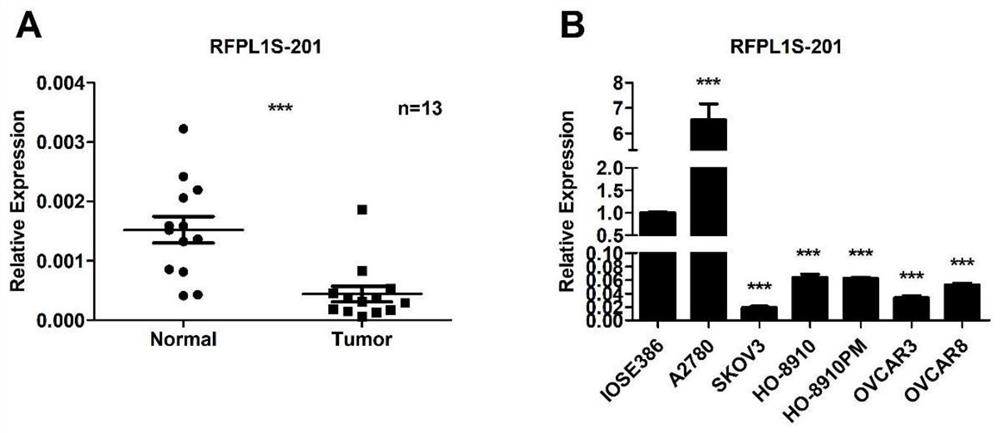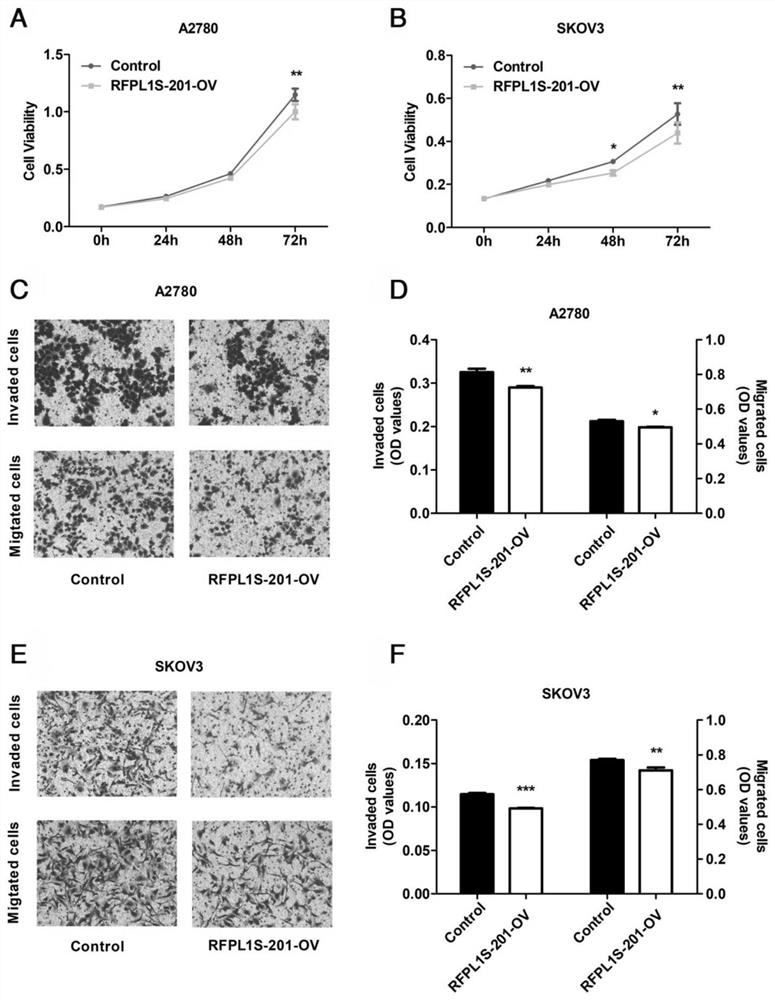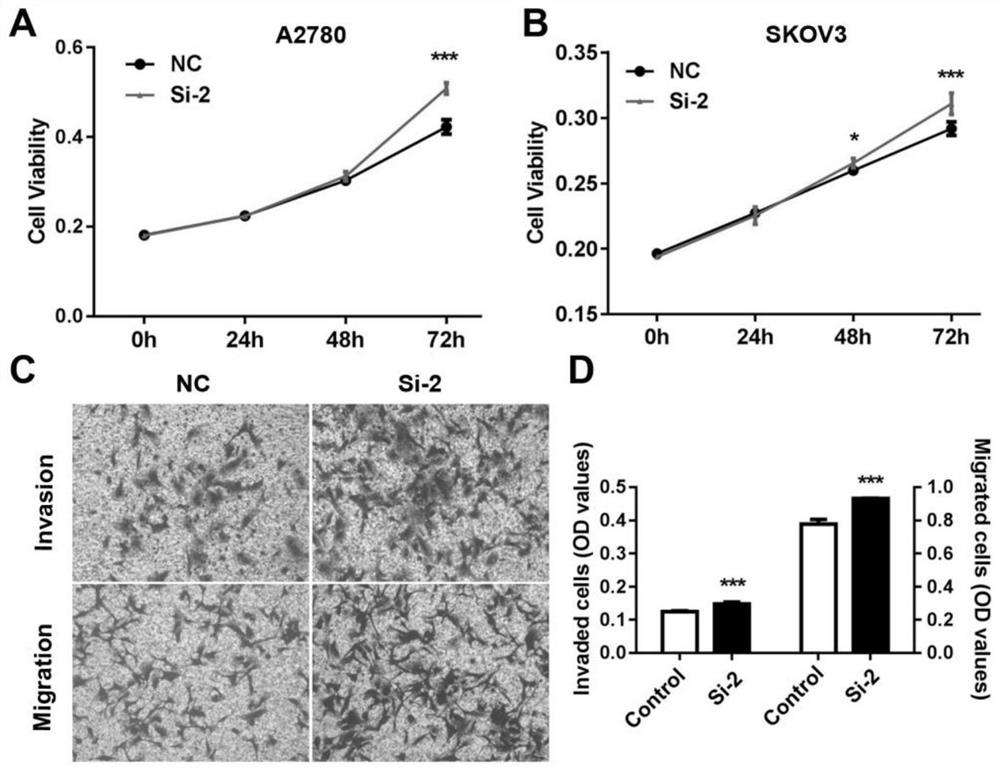Application of RFPL1S-201 in preparation of drugs for inhibiting proliferation, invasion and/or metastasis of ovarian cancer
A technology of RFPL1S-201, 1.RFPL1S-201, applied in the direction of drug combination, anti-tumor drugs, pharmaceutical formulations, etc.
- Summary
- Abstract
- Description
- Claims
- Application Information
AI Technical Summary
Problems solved by technology
Method used
Image
Examples
Embodiment 1
[0044] 1. Cell lines
[0045] The ovarian cancer cell line SKOV3 was purchased from the Cell Bank of the Type Culture Collection Committee of the Chinese Academy of Sciences; the normal ovarian epithelial cell line IOSE386, and the ovarian cancer cell lines A2780, HO-8910, HO-8910PM, OVCAR3, and OVCAR8 were purchased from KGI. Cell culture conditions are as follows:
[0046] Culture medium: SKOV3: McCoy’s 5A incomplete medium (1×) + 10% fetal bovine serum (FBS)
[0047] A2780: DMEM incomplete high-glucose medium (1×) + 10% fetal bovine serum (FBS)
[0048] Digestive solution: 0.25% Trypsin-EDTA (1×)
[0049] Freezing medium: fetal bovine serum (FBS): dimethyl sulfoxide (DMSO): = 9: 1
[0050] 2. Clinical specimens
[0051] The samples in this study were collected from patients undergoing surgery in Nanjing Maternal and Child Health Hospital from 2016 to 2017. A total of 13 normal ovarian tissue samples (from cervical cancer and endometrial cancer with preventive ovary rese...
Embodiment 2
[0061] 1. Construction of RFPL1S-201 interference RNA and overexpression plasmid:
[0062] The interfering RNA sequence of RFPL1S-201 and the control interfering RNA sequence were designed and synthesized by American Thermo Fisher Company.
[0063] The RFPL1S-201 overexpression plasmid pc-RFPL1S-201 was constructed and synthesized by Shanghai Jierui Bioengineering Co., Ltd. on the basis of pcDNA3.1(+), the cloning site is: NheI / NotI, and LncRNA RFPL1S-201 (ENST00000419368. 1) The full length is linked to the cytomegalovirus (CMV) promoter of the pcDNA3.1 vector. Use the OMEGA kit (D6915-03) plasmid to measure the concentration of the extracted plasmid, and detect that the sequence is connected successfully, and use it directly for subsequent experiments or store it at -80°C.
[0064] 2. Cell Transfection
[0065] 1) When the confluence of SKOV3 and A2780 cells cultured in the 6-well plate reached 90%-95%, the RFPL1S-201 overexpression plasmid, control pcDNA3.1 plasmid, RFPL1...
Embodiment 3
[0072] Example 3 Cell Proliferation Experiment
[0073] 1) Count the cells after 24 hours of transient transfection, dilute to the desired concentration with medium containing 10% FBS, and then add the cell suspension to a 96-well plate. Each well contains about 1000 cells in 100μ suspension, and divides into 0 hours. , 24h, 48h, 72h four groups, 5-6 auxiliary wells for each group, placed at 37°C, 5% CO 2 Wait for the cells to adhere to the wall for 3-4 hours in the incubator;
[0074] 2) Measure the cell viability according to the grouping time after the cells adhere to the wall: replace the medium with a mixed solution with 10% CCK-8 reagent, 37°C, 5% CO 2 After reacting in the incubator for 1 hour, detect on a microplate reader, detection wavelength: 450nm.
[0075] see results figure 2 A-B and image 3 A-B; It can be seen from the figure that overexpression of RFPL1S-201 can significantly inhibit the proliferation of ovarian cancer cells, and knockdown of RFPL1S-201 c...
PUM
 Login to View More
Login to View More Abstract
Description
Claims
Application Information
 Login to View More
Login to View More - R&D
- Intellectual Property
- Life Sciences
- Materials
- Tech Scout
- Unparalleled Data Quality
- Higher Quality Content
- 60% Fewer Hallucinations
Browse by: Latest US Patents, China's latest patents, Technical Efficacy Thesaurus, Application Domain, Technology Topic, Popular Technical Reports.
© 2025 PatSnap. All rights reserved.Legal|Privacy policy|Modern Slavery Act Transparency Statement|Sitemap|About US| Contact US: help@patsnap.com



